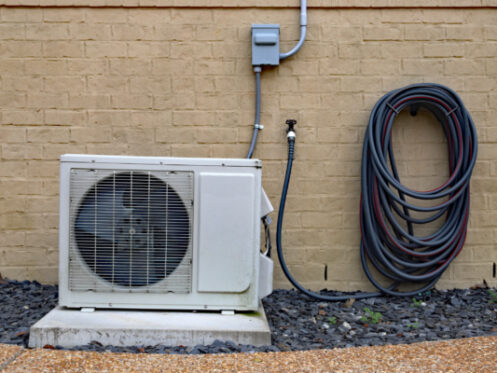If you recently added a room to your home, it might be time to give ductless mini splits a try. Though this type of system isn’t very common, it has a lot of unique advantages. It is helpful to learn a little more about how these unique HVAC systems work to see if a ductless mini-split system is right for you.
What Are Ductless Mini-Splits?
Ductless mini-split systems get their name from two unique features. First of all, these units do not require any air ducts. Unlike a traditional HVAC system that pushes air into ducts around your home, they vent air directly into a room. The other key feature of a mini split is that it consists of several small air handlers divided up around your home. Instead of one big unit for the whole house, you have a small unit with its own thermostat for each room. These air handlers are narrow rectangles that you can mount on the ceiling, below a window, or in another discreet location.
Ductless mini splits come in a few different styles. Some are only air conditioning units that cool your home. Homeowners typically pair this style of mini split with space heaters or a furnace to stay comfortable all year long. Others can both heat and cool the home. This style is often called a ductless mini-split heat pump.
Whichever style you pick, ductless mini splits have the same set of components. There is a single outdoor condenser unit that releases or collects heat outside. This unit connects to several pipes and wires that run to the indoor units. Also called air handlers or evaporators, these indoor units have controls to adjust your temperature and blowers to move air into the home. The largest heat pump mini split accommodates eight air handlers. If you need more than that, buy additional pumps.
The Benefits of Using Ductless Mini Splits
Ductless mini splits are one of the most useful types of HVAC because they let you create a zoning system for your home. With a traditional HVAC system, the same unit applies the same temperature to the entire house. Meanwhile, a ductless mini split lets you set a precise temperature for each area of your house. If one person in your home runs hot, they can set the handler in their room to a lower temperature. You can also use a ductless system to address a hot spot in your home without making the rest of the home unpleasantly chilly.
Another big perk of mini splits is their efficiency. Even if your ducts are very airtight, the air loses its warmth or coolness as it travels through them. A mini-split system can save you up to 30% on your heating and cooling bills. You get even bigger savings once you factor in the ability to only heat or cool one part of your home at a time. If you have a larger house, you can shut the doors to unused rooms and only regulate the areas you actually use.
The final reason people often choose mini splits is that they are simpler to install. Traditional ducted systems require you to fabricate large pieces of ductwork and install them throughout your ceiling, walls, or floor. Meanwhile, a ductless mini split just requires a technician to drill a few small holes in the walls. Not only is this faster to install, but it also requires fewer alterations to your home. If you have a historic home or don’t want to turn your home into an active construction site, ductless systems are a particularly popular choice.
How to Install a Mini-Split System
Overall, a ductless mini-split system is less invasive to install. The largest piece of the system is installed outside on either a concrete pad or to a wall using mounting brackets. From there, your installer will run narrow pipes to the indoor air handlers. These pipes will both cycle refrigerant fluid back and forth and drain condensation outdoors. To add these lines to each new room, your technician will usually cut a small hole of 2 inches to 3 inches wide.
Inside, they complete the installation process by securely mounting air handlers in your desired locations. Usually, air handlers are placed at least six feet up on the wall, so air can distribute evenly around the room. They do best when placed in an unobstructed area away from shelving, furniture, lighting fixtures, or direct sunlight. Though they’re fairly unobtrusive, some people do not like the look of the original unit. In these cases, you can mount an attractive cover over the air handler that obscures it while still letting air flow in and out of the system.
The main challenge when installing a ductless mini split is simply designing the system correctly. Each mini-split system needs to be designed on a case-by-case basis. Your installer will need to carefully measure your home to find the right size and number of indoor units. They’ll need to take into account your home’s layout. Generally, more air handlers of a smaller size will be better than fewer units of a larger size because additional units give you more evenly distributed airflow. Getting the right number of correctly sized units is essential because improperly sized systems are more expensive to operate and more prone to breaking down.
Cooling Your Home With Ductless Mini Splits
Once you install your system, you can start enjoying refreshing, temperature-controlled air. If you’re used to more traditional air units, it can take some time to adjust to mini splits. One of the big differences is that you can use a remote to control your unit instead of having to go to a central thermostat to adjust things. However, if you prefer thermostat controls, some companies are creating units that all connect to a central “smart” thermostat. This can allow you to set routines for cooling and heating your home at certain times, and it can let you control all your units from a single, central location.
Many homeowners start by setting all of their air handlers to the same exact temperature. However, as you get used to the system, you’ll probably find yourself taking advantage of your mini-split’s flexibility. Every home has spots that are warmer or cooler due to the home’s design. Bumping the mini-split temperature down a little in your sunny, window-filled room can help keep it more comfortable while raising the temperature in a cold, shadowy bedroom can get rid of chilly areas. Using different temperatures for different units also banishes arguments about what temperature to set your AC at because every family member can pick their own preferred temperature.
If you’re interested in trying out ductless mini splits, Billfish Air Conditioning is happy to assist you. We provide expert air conditioning and heating service in Stuart, FL. Our technicians are trained to work on a variety of residential and commercial HVAC systems, and we offer all sorts of installations, repairs, and maintenance. To schedule an appointment with the Billfish Air Conditioning team, give us a call today.






